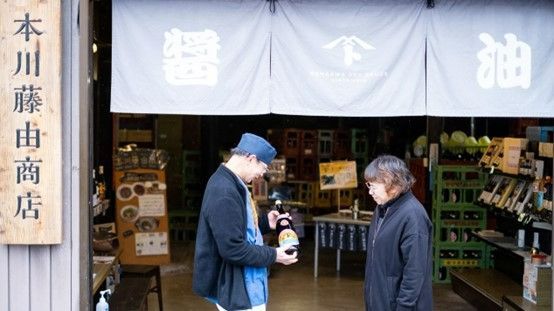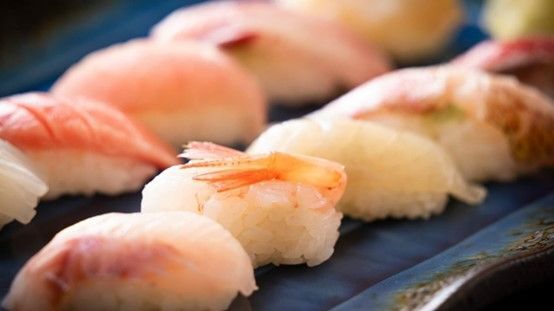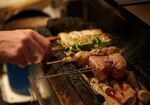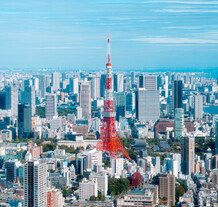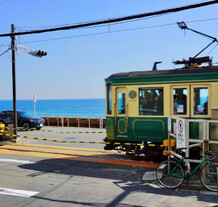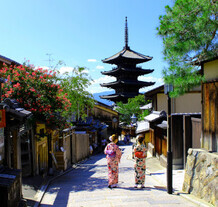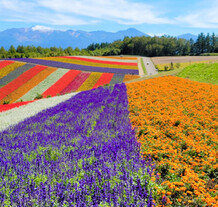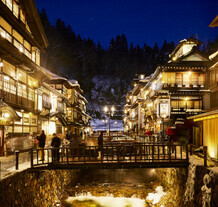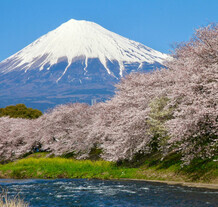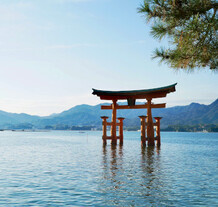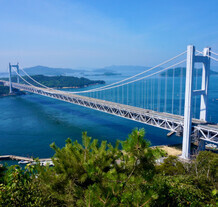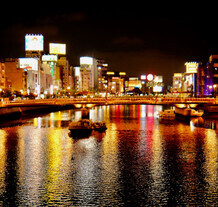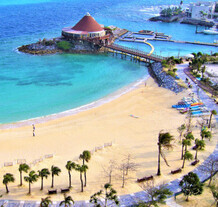Himi City in Toyama Prefecture is known for producing high-quality fish
such as "Himi kanburi" (winter yellowtail) and "Himi
iwashi" (sardines), and it is renowned as one of the leading fishing towns
in Toyama with fish that are exceptionally fresh, known as "kitokito"
in the local dialect. The Himi fishing port is the foremost port in Toyama that
collects such fresh fish. The secret to their freshness lies in the fixed-net
fishing method that has been passed down for over 400 years. In this local
area, fish has always been the most treasured delicacy due to the abundance of
fresh fish from the fishing port. As a result of the local culture, the custom
of eating fish dishes and sushi at celebrations and banquets has naturally
evolved over time. In fact, many unique "machi-zushi" (town sushi)
that mix both old and new styles can still be found in Himi City today. We
explored the allure of Himi's "kitokito" machi-zushi that has been
nurtured by its history and culture, as well as the fishing methods and soy
sauce making that support the sushi.
"Kiyomizu," a machi-zushi restaurant that prioritizesfreshness, is located right in front of the Himi fishing port where the ownervisits every morning
If viewed from above, it is easy to see that the Himi Strait, where fixed nets are installed, curves from the base of the Noto Peninsula in the northwest of Toyama Bay
'Kitokito' sushi is made using the fixed-net fishing method that hasbeen continuing for over 400 years."
If asked where in Toyama is the best place to catch delicious fish, manypeople would immediately answer with "Himi fishing port". In fact,Himi fishing port boasts the largest catch of a variety of fish species,including brand fish such as "Himi kanburi" and "Himiiwashi", making it the largest fishing port in Toyama in terms of catchvolume.
Himi's sea is located on thewest side of Toyama Bay, which is the largest oceanic inlet in the Sea ofJapan. There is a continental shelf off the coast of Himi, which ischaracterized by a suitable topography for fixed-net fishing. Plankton isabundant due to the snowmelt water flowing from the mountains, and the seaweedbeds are extensive. Schools of fish that migrate from the northern sea gather hereto spawn.
Furthermore, even in thewinter, when the Sea of Japan is rough due to northwestern winds, Himi is aplace where fishing is possible all year round including winter, as the windsare blocked by the Noto Peninsula. With such favorable conditions, Himi hasbeen a thriving town in fishing and aquatic processing since ancient times.
Naturally, people livingthere have been eating various local fish as a part of their daily diet for along time. Sushi has also been popularized as one of the cooking methods toenjoy "fresh fish" in the area.
![Travel to taste the exceptionally fresh 'Machi-Zushi' (Town Sushi) inHimi, one of Japan's leading fishing towns]()
The morning auction at the Himi fishing port
Before discussing the outstandingly fresh sushi from Himi, I would liketo touch upon Himi's fishing a bit.
When it comes to Himi's fishing, the fixed-net fishing that wascertified as a "Japanese Nationally Important Agricultural HeritageSystem" in 2020 is the mainstream. Its history dates back at least 400years, as evidenced by a 1615 document that describes a "fixed net for catchingbluefin tuna in the summer."
A fixed net is a fishing method that involves setting a large net on thecontinental shelf and waiting for fish that are migrating to naturally enter.It's a kind of trap set in the sea to catch fish. According to reports, about30% of the fish that migrate get trapped in the net and cannot escape, makingit an environmentally friendly fishing method that has attracted particularattention in recent years.
In fact, the reason why Himi's fish is so fresh is mainly due to thisfixed-net fishing method. There are six fishing ports in Himi, but all of themset fixed nets in the near sea, about 2 to 4 kilometers from the shore. Ittakes about 20-30 minutes to get to the fishing grounds and about 30 minutes toan hour to raise the net, so the fish that were swimming in the sea until 3a.m. line up at the morning auction that starts at 6 a.m.
To sell the freshness of the fish, the way they are handled after beingcaught is also carefully designed. Fish other than live fish are immediatelyput on ice and sealed as soon as they are caught, a practice that is thoroughlyadhered to by fishermen to maintain freshness.
Thus, having pride in thefreshness of the fish that has just been caught is the essence of Himi'sfishermen, and this sentiment has been passed down to the chefs of Himi aswell.
The reason why an owner with the right to participate in the fishauction personally selects the fish for use in sushi
"Kiyomizu" shop owner, Mr. Yuichi Shimizu
Ifyou want to eat sushi made with fresh fish from Himi, then you definitely wantto visit the sushi restaurant "Kiyomizu", located right in front ofthe market.
Every morning, the owner, Mr. Shimizu, carefully selects the fishhe will use as ingredients for his sushi from the fish caught on that day atthe market.
"Since my family has been in the fish business up until my father'sgeneration, I have the privilege of purchasing fish directly from marketauctions. That's why I visit the auction every morning. I personally select thefish that I will use for my sushi and I judge the quality by examining thefish's eyes and the lower part of its belly. Fish with plump bellies are oftenthe most delicious," says Mr. Shimizu, showing us the fish he just boughtupon returning from the market.
On this day, he purchased ice-cold young bluefin tuna, amberjack,mackerel, as well as live flounder and snapper.
![Travel to taste the exceptionally fresh 'Machi-Zushi' (Town Sushi) inHimi, one of Japan's leading fishing towns]()
The freshly filleted flounder meat. After this, a little salt is added to draw out the moisture and concentrate the flavors
While talking, he doesn't stop his hands from filleting the fish. It'sMr. Shimizu's daily routine to process the fish he bought each morning fortheir respective dishes while listening to the radio.
"I think there are fewplaces outside of Himi where fish that were swimming lively in the sea untilaround 3 a.m. become sushi for lunch. The freshness is the weapon of the sushimade here. That's why I immediately process what I've bought to maximize itsfreshness," says Mr. Shimizu.
He offers us the filleted flounder meat and shows us the flounder’s edgepart that's still twitching. This is proof that the nerves are still alive. Heexplains that this wouldn't have happened if he hadn't personally performedikejime on the fish and immediately removed its guts and bones. The key is tofillet the fish without allowing it to undergo rigor mortis. He tells us thatthere is a significant difference in taste between fish that have and have notundergone rigor mortis.
Sushi that is loved by both locals and tourists
Mr. Yuichi Shimizu, who has been on this path for 28 years
Mr. Yuichi Shimizu became a sushi chef at the age of 22. Aftergraduating from university, he wanted to try running a sushi restaurant usingthe fish from Himi, where his father was a fishmonger.
He worked at a restaurant inKanazawa for 5 years and opened his long-awaited sushi restaurant in Himi atthe age of 27. He uses fish that have been caught as much as possible from theHimi fishing port in front of him. The seasoning and cooking of the vinegaredrice are inherited from the way of the Kanazawa restaurant where he trained.
However, Mr. Shimizu has hisown obsession with "matching fresh fish with high-quality rice." So,he mills the Koshihikari rice sourced from the contracted farmers of his familybefore every business day, only for the amount he will use.
![Travel to taste the exceptionally fresh 'Machi-Zushi' (Town Sushi) inHimi, one of Japan's leading fishing towns]()
From the front, we have amberjack, flounder, and mackerel. All of themare fish that were just caught at the port of Himi on this day
I try the sushi that was handed to me rightaway. When I put it in my mouth, I can feel a much more substantial volume thanI expected.
The toppings are cut slightly thicker, and the flounder has a unique, chewytexture that pairs well with the sweet vinegar rice, which doesn't emphasizethe acidity of the vinegar too much. Amberjack and mackerel are also cutslightly thicker, and after enjoying their chewy texture, the aroma and umamiof the fish gently spread in my mouth.
The sushi at "Kiyomizu" is different from the charm of traditionalEdo-style sushi, which is made with sharp vinegar rice with a sharp flavor.It's sushi where the fish is the star of the show. The pure, unadulteratedfish, which is not subjected to any processing such as kelp or vinegar marinatingor aging, is gently supported by the mild vinegar rice. Sushi that makes youfeel the vast and accommodating sea is unique and charming.
![Travel to taste the exceptionally fresh 'Machi-Zushi' (Town Sushi) inHimi, one of Japan's leading fishing towns]()
12 pieces of chef's special nigiri (4,000 yen). They are served in order at the counter, and as an assortment at the table
The chef's special sushi course features not only fish caught in theHimi fishing port but also ingredients from Toyama Bay, such as sweet shrimp,Japanese glass shrimp, and Japanese babylon from Shinminato. The Japanese glassshrimp has a sticky yet gentle texture, while the Japanese babylon has acrunchy texture reminiscent of the sea and a scent of seaweed. The taste ofthese ingredients is also notable for their freshness.
The menu for the banquet course also includes Ala Carte dishes such as crab tomalley salad (1,200 yen)
At Kiyomizu, about 80% of the customers are locals and 20% are fromother prefectures. Many female customers also visit the restaurant, and themost popular dishes among regulars are sashimi, crab tomalley salad, simmereddishes such as grilled pike conger with sauce, Japanese glass shrimp tempura,grilled dishes, and a "sushi banquet" that includes four types ofsushi (4,400 yen, reservation required). It is said that many people bookprivate rooms to celebrate special occasions or have banquet parties. Fortravelers who have time, it would also be a good idea to try this course.
The charm of local cuisine is being able to feel the food culturenurtured by the local climate and history. Machi zushi, which has been nurturedby the climate and history of Himi, is also enjoyable to visit casually. Pleasecome to Himi and sit at the counter to enjoy the outstanding freshness of theunique sushi here while chatting with the owner.
きよ水 Kiyosui
Contact number: 0766-72-2511Address: 8-22 Chuomachi, Himi,Toyama 935-0011
Hours of Operation: 11:30~14:00and 17:00~21:00 Thursday thru Tuesday
Closed: Wednesday, first Thursday of the month
Number of seats: 7 counterseats and 35 table seats
Travelers' stopping spot: Himi Banya-gai, outside of Himi Fishing Port Market
When visiting Himi, a place you must stop by is the "HimiBanya-gai". Here, you can purchase fresh fish that is lined up at themarket (which can also be shipped). In addition, there is a variety ofdelicious local food perfect for souvenirs, such as Himi udon noodles and ricebran pickles. There are also shops where you can eat light meals such as Himibeef and ramen, as well as natural hot springs facilities with hot springs sourceddirectly from the springs. It is recommended to take a little time and enjoyyour visit.
氷見漁港場外市場 ひみ番屋街 (A Trip Stopover Himi Fishing Port Market - Himi Tradesman's Shopping Street)
Address: 25-5 Kitaōmachi,Himishi, Toyama 935-0004
Contact number: 0766-72-3400
Hours of Operation:8:30~18:00
Closed: irregular daysdepending on the schedule of each store
“Kawaki" is a restaurant where you can fully enjoy the fish caughtin front of Himi with sushi and dishes
The delicious relationship between the soy sauce of Himi and sushi
The Minato River that flows through the city of Himi
When it comes to the scenery of Himi, thesnow-capped Tateyama mountains visible beyond the sea are famous, but there arealso several beautiful places within the town itself.
One of these places is the Minato River thatflows through the city. Along both sides of the narrow river that connectsJyunigata and the sea, there are traditional buildings and several uniquelydesigned bridges. The sushi restaurant "Kawaki" blends perfectly intothe townscape, serving seasonal fish caught in Himi as both a la carte dishesand sushi prepared in the traditional kappo style.
Exterior that blends well into the tranquil townscape
When I visited the shop before opening hours, I happened to run into theowner, Mikihisa Yokawa. He was on his way to "Honkawa Fujiyu Shoten,"which was about a 3-minute walk away, to pick up the soy sauce he uses. Heallowed us to accompany him.
Did you know that Himi's soysauce is a little different from the typical soy sauce found in Tokyo andelsewhere? Himi's soy sauce is slightly sweet. This soy sauce is anindispensable part of Himi's sushi that the locals say that when they eatsushi, it just doesn't feel right if it's not with this sweet soy sauce.
So why is soy sauce producedin this unique way in Himi? Before dining at "Kawaki," I wanted toask this question at "Honkawa Fujiyu Shoten."
Mr. Mikihisa Yokawa from Kawaki and Ms. Michiko Morita from "Honkawa Fujiyu Shoten."
After walking for a while, a particularly elegant building along theMinato River came into view. This building is the "Honkawa FujiyuShoten," which was established in 1870 during the Meiji period.
Perhaps because of the localgeography, many of the soy sauce shops in Himi started out as fisherycompanies. Honkawa Fujiyu Shoten is no exception, having originally been thehome of a fishery company. The unique origins of the company are tied to thehistory of the town, which has long relied on fishing as its main industry, andto stories from the Edo period of fixed-net fishing. During that time,fishermen slept and ate on their boats, with meals consisting of freshly caughtfish and white rice. Each fishery company made its own miso to flavor thesemeals, and over time, some of these companies began producing tamari soy saucethat would complement the flavor of fish. This became a source of income forsome fishery companies.
"Our soy sauce isseasoned and cooked, then aged in our own brewery for at least a month. Thebrewery's koji bacteria gives the soy sauce a mellow flavor," says Ms.Michiko Morita of Honkawa Fujiyu Shoten. "Himi yellowtail, which has a lotof fat, tends to repel soy sauce, but a slightly thick and sweet soy sauce likeours can stand up to the richness of the fish fat. It really goes well withsashimi," she adds.
For Mr. Yokowa, the owner ofKawaki, this soy sauce is indispensable for his sashimi and sushi. He mentionsthat while there used to be five soy sauce shops in Himi, now there are onlytwo left. While walking down the street, he expresses his desire to continueusing the soy sauce that has supported Himi's food culture alongside sushi.
Prepare fresh fish from Himi using the techniques of a Ryotei
"Kawaki" has 5 seats in front of the counter and private rooms
Mr. Yokawa, the second generation of "Kawaki," currently runsthe restaurant at its current location every day. As a Himi's local's way toenjoy the sushi, he mentioned that many people enjoy eating fish dishes withsake and finishing with sushi. The reason why "Kawaki" has been lovedby local people for many years is that it has continued to evolve by meetingsuch needs.
The beginning of"Kawaki" was when Mr. Yokawa's father turned his grandfather's fishstore into a sushi restaurant. As his mother started to make simple dishes toaccompany the sake they were serving, the restaurant became prosperous.However, Mr. Yokawa, who had been seeing only fish since he was a child,actually disliked fish. He decided to take over the restaurant even though hehad no interest in it, when he returned to his hometown after spending time inthe city and realized once again how delicious the fish in Himi was.
After deciding to take overthe restaurant, he studied sushi in Osaka and trained in cooking at a KyotoRyotei to be able to offer more authentic dishes and sushi. Since taking overthe restaurant, he has started serving not only sushi but also dishes thatutilize ingredients prepared in the Kyoto style.
Having cooked for a longtime in other prefectures and handled various ingredients, Mr. Yokawa firmlyasserts that the fish in Himi can be boasted about to the world. "Thereare many types of fish caught in Himi, and there are many good fatty fish.Also, the taste is completely different between the beginning and end of theseason. I hope that people will visit Himi many times not only in spring,summer, fall, and winter but also at the beginning and end of the seasons toenjoy the difference in taste," he said.
![Travel to taste the exceptionally fresh 'Machi-Zushi' (Town Sushi) inHimi, one of Japan's leading fishing towns]()
Assorted superior nigiri sushi plate of 10 pieces including soup for2,500 yen. On this day, it includes spear squid, yellowtail, sweet shrimp,flounder, tuna, crab, local octopus, and Japanese glass shrimp. You can alsoorder individual pieces of sushi starting from 152 yen per piece As a chef, he often thinks about how to bringout the best in the ingredients when considering what kind of fish to use forsushi. For example, they cut freshly prepared Hong Kong grouper for lunch sushiso that customers can enjoy the texture and elasticity of the just-caught fish.They process with kelp for flounder to condense the flavor. They let the fattybelly of yellowtail rest for a day, but immediately make sushi with the back sideto enjoy its fresh aroma, and so on.
"For spear squid, it's better to make sushi with it as soon as it'scaught. Octopus also tastes completely different if you boil it right awayafter it's caught. I think that the fresh fish that people in Himi value somuch can bring out various flavors depending on the way it's cooked, not onlyjust by itself."
They use Koshihikari rice from Himi for the vinegared rice. They make a gentleand mellow flavor by using rice vinegar, mirin, sugar, and salt without losing theflavor and aroma of the fish.
To bring out the personality of each type of fish, they use vinegared rice thatsuppresses the personality of the rice. With this balance, they highlight thevarious expressions of the fish. The sushi at "Kawaki" is also asushi that puts the fish in the spotlight. Unlike lively sushi that emphasizesfreshness, it is sushi that allows you to feel the various expressions ofHimi's fish.
![Travel to taste the exceptionally fresh 'Machi-Zushi' (Town Sushi) inHimi, one of Japan's leading fishing towns]()
Stock made with Himi sardines, which is the base for all dishes.
Eating sushi with soy sauce mixed with stock made from sardines, mirin, and "Honkawa Fujiyu Shoten"
Mr. Yokawa's desire to bring out the "natural taste" of Himifish is also reflected in the soy sauce he uses for sushi, where he takes anextra step. While taking advantage of the individuality of the soy sauce from"Honkawa Fujiyu Shoten '' that we visited at noon, he dilutes it withHimi's sardine broth and mirin to make it a little mellower.
"Himi's sardine brothis very elegant. It goes well with any dish, and I feel that diluting this soysauce a little more brings out the flavor of the fish even more." As thesewords suggest, the rounded diluted soy sauce with softened corners has amoderate sweetness and a refined taste. It can be said to be the unsung hero ofenjoying sushi.
Deep-fried plaice. Market price is around 850 yen
At "Kawaki", it is recommended to also order Ala Carte besidessushi. The dish of plaice with remarkable freshness that could be eaten assashimi, deep-fried dynamically, or the simple salt-grilled yellowtail with anamazing amount of meat attached, are luxurious treats unique to a port town.
In addition, there aredishes that go well with alcohol, such as grilled fish marinated in Saikyo misoand "snapper roe simmered in sweetened soy sauce." All of themdemonstrate the chef's skill in carefully identifying the ingredients andbringing out their deliciousness.
Grilled salted yellowtail collar (market price)
There are many dishes that you would want to eat while drinking sake,but surprisingly, they only have two types of sake from each of the twotraditional breweries with old-fashioned flavors. One is "Tateyama SakeBrewery" from Tonami City, Toyama Prefecture, and the other is "TakasawaSake Brewery" from Himi City, which both have a selection for chilled andwarm sake.
"I feel like the recentstrongly flavored sake doesn't really enhance the taste of the fish. I wantpeople to enjoy the taste of the fish, so I prefer an old-fashioned clean andrefreshing sake that doesn't interfere with the flavor of the fish. That's whywe only have sake from these two breweries. If you want to drink your favoritesake, please consult with us about bringing it," says Mr. Yokawa.
His love for fish is evidenteven in such details.
"Akebono" by "Takasawa Sake Brewery," the only sake brewery in Himi City, is served warm
When you come to "Kawaki," the Japanese-style room where youcan relax is nice, but the counter where you can talk to the owner, Mr. Yokawa,is a special seat. This is the platinum seat where only four people can sit. Ifyou wish to sit at the counter, please make a reservation in advance andconsult with them.
In the evening, take aleisurely walk along the Minato River and head to the restaurant. Sit at thecounter and enjoy local sake while chatting with Mr. Yokawa, and savor therecommended local fish with local soy sauce. From Ala Carte to sushi, you canfully experience the charm of Himi's fish.
川喜(かわき)Kawaki Contact number: 0766-74-5555
Address: 2-1 Honmachi, Himi, Toyama 935-0016
Hours of Operation: 11:30~14:00 and 17:00~21:00 Tuesday thru Sunday
Closed: Monday
Travel Stopover Spot: “HonkawaFujiyu Shoten”
Oneof the two remaining soy sauce shops in the city, beloved by restaurants inHimi. They offer a variety of soy sauce ranging from basic dark soy sauce andlight soy sauce to sashimi soy sauce, tofu soy sauce, and broth soy sauce. It'salso nice that you can taste various soy sauces before purchasing them at thestore. They also sell small bottle sets that are perfect for souvenirs. It's aplace you'll want to stop by during a walk along the Minato River.
本川藤由商店 (A Trip Stopover Hongawatouyu Store)Address: 1-18 Honmachi,Himishi, Toyama 935-0016
Contact number: 0120-720-702
Hours of Operation: 9:00~17:00Monday to Saturday
Closed: Sunday and nationalholiday
If you want to enjoy Himi's fresh machi-zushi, there are still seven places to go
Himi City has unique machi-zushi restaurants. We will introduce you to the"kitokito" machi-zushi that has been nurtured by history and culture.
やうち(Yauchi)
Address: 14-13 Himimachi,Himishi, Toyama 935-0012
Contact number: 0120-720-702
Hours of Operation:12:00~14:00; 17:00~21:00 Monday to Wednesday
Closed: Thursday
Number of seats: 9 counterseats and 8 table seats
Located along the Minato River that flows through the city center, thissushi restaurant has aimed to be an "approachable sushi restaurant"since its establishment in 1974, with prices listed for each fish. Freshseafood is sourced every morning from local fishmongers at a reasonable priceunique to a port town, delivering a sense of security and deliciousness to itscustomers. Recommended dishes include "Superior nigiri" and"Yauchi soup." English language support is also available.
Mr. Kawahara, the shop owner, greets customers with a gentle smile. The name of the shop, "Yauchi," is a dialect word from the Himi region and is mainly used among fishermen to call each other
You can enjoy the "Superior nigiri" (2,200 yen), which is made from locally caught fish on that day. At the counter, you will be served freshly made nigiri sushi one by one
"Yaucchi soup" (400 yen) is a soup that contains three or more types of fish. It is made after ordering, so there is no miscellaneous taste, and the high-quality flavor spreads in your mouth
朝日(Asahi)
Address: 7-9 Asahihonmachi,Himishi, Toyama 935-0022
Contact number: 0766-72-4327
Hours of Operation: 16:30~23:00Wednesday to Monday
Closed: Tuesday
Number of seats: 6 counterseats and 10 table seats
The friendly shop owner stands behind the counter and makes sushi usinglocal fish and rice. Sushi can be ordered for around 1,500 to 2,000 yen byleaving it to the chef's choice. Other dishes such as sashimi and simmereddishes are also available, and you can enjoy them with local sakerepresentative of Toyama such as "Tateyama" and "Akebono".It's a popular place among the locals where you can enjoy sushi reasonably withclose friends without being too formal or uptight.
亀寿し(Kame Sushi)
Address: 5-26 Honmachi,Himishi, Toyama 935-0016
Contact number: 0766-74-3310
Hours of Operation: 16:30~23:00Thursday to Tuesday; reservation required before evening
Closed: Wednesday
Number of seats: 12 counterseats and 10 table seats
This is a restaurant where you can enjoy seasonal fish caught in theHimi fishing port as sushi and Ala Carte. As the type of fish and prices differdepending on the day's catch, they purposely do not provide a menu, but theprices are reasonable, so there is no need to be too nervous. You can order"omakase" (Chef's choice) from the chef and then feel free to consultwith them about your preferences and budget if you have any. It is recommendedto make a reservation in advance from noon to evening or for family and groupuse.
松葉寿司(MatsubaSushi)
Address: 7-21 Marunouchi,Himishi, Toyama 935-0017
Contact number: 0766-72-0266
Hours of Operation:11:30~13:30; 17:00~20:30 Monday to Saturday
Closed: Sunday and irregularclosed days
Number of seats: 20 table seats
Forover 60 years since its founding, this second-generation chef continues tooffer the same taste at the counter. The sushi toppings that come on top of thesushi geta have a good thickness and excellent texture. The "Superiorchirasi sushi," which has over 10 different toppings scattered under theegg threads and salmon roe, is also popular. The tatami-matted raised seatingarea is cozy and easy to use for groups and families.
Mr. Kushida, the owner, runs the restaurant with his wife. He expertly crafts sushi with a smooth and lively tempo backed by years of experience
The "Superior chirashi sushi" (2,000 yen) is covered with brightly colored egg threads. It's like a treasure hunt to see what kind of fish are included, and it's a fun experience to savor
The restaurant has a spacious and relaxed interior. About 40 years ago, during a reconstruction, the owner decided to remove the counter to make it a sushi restaurant that is more welcoming for families
橘寿司(Tachibana Sushi)
Address: 11-11 Honmachi,Himishi, Toyama 935-0016
Contact number: 0766-74-4688
Hours of Operation: 17:0~23:00Reservation only for lunch
Closed: Irregular closed day
Number of seats: 9 counterseats and 12 table seats
Sinceits establishment in 1977, it has hung its shop curtain near JR Himi Station.The fish caught in Toyama Bay are lined up in the case in front of the counter.The balance of sweetness and sourness in the shari rice further enhances thegoodness of the toppings. There is also a variety of snacks that pair well withJapanese sake, such as Toyama's specialty "kurozukuri" (cuttlefishsalted and mixed with its own ink) and homemade "shrimp miso." Afterdrinking, it is recommended to order sushi for a satisfying end to the meal andto fully enjoy the delights of counter sushi.
According to the owner, Mr. Ono, it is a "friendly and relaxed restaurant where you can drink and eat comfortably." There are also many regular customers who visit in anticipation of enjoying conversations with Mr. Ono
The price for the chef's special sushi is around 2,000 yen. The sushi includes ingredients that are typical of Toyama, such as battleships wrapped in shredded tangle of kelp with Japanese glass shrimp from Shinminato
From right to left: "Sea cucumber in sweetened vinegar" (400 yen), "Kurozukuri" (300 yen), and "Shrimp Miso" (600 yen). The restaurant stocks sake from Takasawa Sake Brewery
参志郎(Sanshirou)
Address: 165-2 Ao, Himishi,Toyama 935-0002
Contact number: 0766-74-6120
Hours of Operation: 17:00~24:00Thursday to Tuesday
Closed: Wednesday and irregularclosed day
Number of seats: 6 counterseats and 10 table seats
A sushi restaurant stands in a peaceful location a little away from thecity center. The interior of the restaurant gives a popular feeling reminiscentof restaurants and Japanese style dining bars. Local customers make up 90% ofthe clientele, and some regulars bring four generations of their family. Theassorted sushi platter, centered on local fish, is priced at around 2,000 yen.Depending on the type of fish, the restaurant draws out the flavor by aging thefish. They also prepare sashimi, sweetened vinegar dishes, grilled dishes, etc.upon request.
Mr. Yamamoto has been running his shop at this location since his twenties. He laughs cheerfully, saying "I've been doing it while being led by the customers in a good way”
The moment you put the sushi in your mouth, you can feel the rich flavor of the sushi toppings. Local fishermen also visit the restaurant frequently, assuring on the deliciousness of the fish
The grilled snapper, which is baked until it is plump, costs around 700 yen (market price). It's also great that the restaurant is open until late at night, and it's easy to get carried away with drinking alcohol
菅隆(Sugaryu)
Address: 7-19 Marunouchi, Himishi, Toyama 935-0017
Contact number: 0766-72-0394
Hours of Operation: 12:00~14:00; 17:30~21:30 Friday toWednesday
Closed: Thursday and irregular closed days
Number of seats: 23 table seats
Thisis a Japanese restaurant that focuses on course meals, including sushi. Thecourse meal (6,600 yen~) consists of seven dishes, including sushi, andrequires reservations made the day before. You can feel the seasonality of eachdish, and you can also appreciate the careful work of the second-generationchef, who trained at a traditional Japanese restaurant in Kansai. The restauranthas private rooms for all seats, making it perfect for celebrating occasionssuch as birthdays and anniversaries. It's a great place to spend time relaxingwith your loved ones without any hesitation.
The owner, Mr. Sugahara, honed his skills in Kyoto and Osaka and took over the signboard of the shop that his father founded. He also serves as the chairman of the Himi Sushi Association
The sushi made with seasonal fish has an elegant and refined appearance. It is served as a small appetizer or as a part of a meal in course menus, and it satisfies both the stomach and the heart
"Abalone cream croquette" (an example from a 10,000 yen course). The mayonnaise made from the liver, served alongside the croquette, adds even more depth to the rich flavor
Disclaimer: All information is accurate at time of publication.














